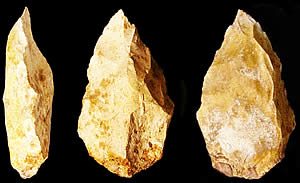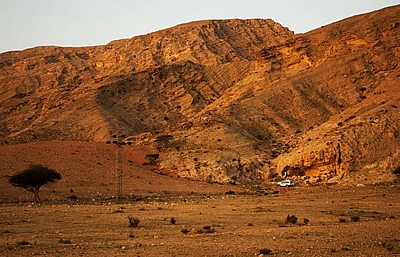
Hand axe pre-form. For more information, please see figure S5 in the Supporting Online Material, and for Additional Assemblage C material, please see Figure 2 in the manuscript. (Image © Science/AAAS)
Humans may have found the Arabian Peninsula as long as 125,000 years ago
Washington, D.C.–(ENEWSPF)– Artifacts unearthed in the United Arab Emirates date back 100,000 years and imply that modern humans first left Africa much earlier than researchers had expected, a new study reports. In light of their excavation, an international team of researchers led by Hans-Peter Uerpmann from Eberhard Karls University in Tübingen, Germany suggests that humans could have arrived on the Arabian Peninsula as early as 125,000 years ago — directly from Africa rather than via the Nile Valley or the Near East, as researchers have suggested in the past.
The timing and dispersal of modern humans out of Africa has been the source of long-standing debate, though most evidence has pointed to an exodus along the Mediterranean Sea or along the Arabian coast approximately 60,000 years ago.
This new research, placing early humans on the Arabian Peninsula much earlier, will appear in the 28 January issue of Science, which is published by AAAS, the nonprofit science society.
The team of researchers, including lead author Simon Armitage from Royal Holloway, University of London, discovered an ancient human toolkit at the Jebel Faya archaeological site in the United Arab Emirates. It resembles technology used by early humans in east Africa but not the craftsmanship that emerged from the Middle East, they say. This toolkit includes relatively primitive hand-axes along with a variety of scrapers and perforators, and its contents imply that technological innovation was not necessary for early humans to migrate onto the Arabian Peninsula. Armitage calculated the age of the stone tools using a technique known as luminescence dating and determined that the artifacts were about 100,000 to 125,000 years old.
"These ‘anatomically modern’ humans — like you and me — had evolved in Africa about 200,000 years ago and subsequently populated the rest of the world," said Armitage. "Our findings should stimulate a re-evaluation of the means by which we modern humans became a global species."
Uerpmann and his team also analyzed sea-level and climate-change records for the region during the last interglacial period, approximately 130,000 years ago. They determined that the Bab al-Mandab Strait, which separates Arabia from the Horn of Africa, would have narrowed due to lower sea-levels, allowing safe passage prior to and at the beginning of that last interglacial period. At that time, the Arabian Peninsula was much wetter than today with greater vegetation cover and a network of lakes and rivers. Such a landscape would have allowed early humans access into Arabia and then into the Fertile Crescent and India, according to the researchers.
"Archaeology without ages is like a jigsaw with the interlocking edges removed — you have lots of individual pieces of information but you can’t fit them together to produce the big picture," said Armitage. "At Jebel Faya, the ages reveal a fascinating picture in which modern humans migrated out of Africa much earlier than previously thought, helped by global fluctuations in sea-level and climate change in the Arabian Peninsula."

View of northern Jebel Faya from the north-east. The Jebel comprises Neogene limestones with rich seams of chert. The FAY-NE1 rockshelter is behind the white vehicle. (Image © Science/AAAS)
This report by Armitage et al. was funded by the Government of Sharjah, the ROCEEH project (Heidelberg Academy of Sciences), Humboldt Foundation, Oxford Brookes University and the German Science Foundation (DFG).
The American Association for the Advancement of Science (AAAS) is the world’s largest general scientific society, and publisher of the journal, Science (www.sciencemag.org) as well as Science Translational Medicine (www.sciencetranslationalmedicine.org) and Science Signaling (www.sciencesignaling.org). AAAS was founded in 1848, and includes some 262 affiliated societies and academies of science, serving 10 million individuals. Science has the largest paid circulation of any peer-reviewed general science journal in the world, with an estimated total readership of 1 million. The non-profit AAAS (www.aaas.org) is open to all and fulfills its mission to "advance science and serve society" through initiatives in science policy; international programs; science education; and more. For the latest research news, log onto EurekAlert!, www.eurekalert.org, the premier science-news Web site, a service of AAAS.








